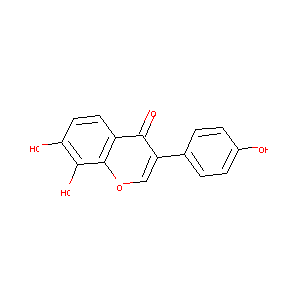Details of the Drug
General Information of Drug (ID: DM80GFL)
| Drug Name |
7,8,4'-trihydroxyisoflavone
|
||||||||||||||||||||||
|---|---|---|---|---|---|---|---|---|---|---|---|---|---|---|---|---|---|---|---|---|---|---|---|
| Synonyms |
7,8,4'-Trihydroxyisoflavone; 8-Hydroxydaidzein; 75187-63-2; 4',7,8-Trihydroxyisoflavone; 7,8-Dihydroxy-3-(4-hydroxyphenyl)chromen-4-one; 7,8-Dihydroxy-3-(4-hydroxy-phenyl)-chromen-4-one; 7,8-Dihydroxy-3-(4-hydroxyphenyl)-4H-chromen-4-one; NSC678112; CHEMBL242739; NSC 678112; 4H-1-Benzopyran-4-one, 7,8-dihydroxy-3-(4-hydroxyphenyl)-; 7,4'-Trihydroxyisoflavone; AC1NV1M1; SCHEMBL571127; 7,8,4''-trihydroxyisoflavone; 4'',7,8-trihydroxyisoflavone; CTK5E1244; DTXSID20226169; MolPort-000-165-583; BMZFZTMWBCFKSS-UHFFFAOYSA-N
|
||||||||||||||||||||||
| Indication |
|
||||||||||||||||||||||
| Drug Type |
Small molecular drug
|
||||||||||||||||||||||
| Structure |
 |
||||||||||||||||||||||
| 3D MOL | 2D MOL | ||||||||||||||||||||||
| #Ro5 Violations (Lipinski): 0 | Molecular Weight (mw) | 270.24 | |||||||||||||||||||||
| Logarithm of the Partition Coefficient (xlogp) | 2.1 | ||||||||||||||||||||||
| Rotatable Bond Count (rotbonds) | 1 | ||||||||||||||||||||||
| Hydrogen Bond Donor Count (hbonddonor) | 3 | ||||||||||||||||||||||
| Hydrogen Bond Acceptor Count (hbondacc) | 5 | ||||||||||||||||||||||
| Chemical Identifiers |
|
||||||||||||||||||||||
| Cross-matching ID | |||||||||||||||||||||||
Molecular Interaction Atlas of This Drug
 Drug Therapeutic Target (DTT) |
|
||||||||||||||||||||||||||
|---|---|---|---|---|---|---|---|---|---|---|---|---|---|---|---|---|---|---|---|---|---|---|---|---|---|---|---|
 Drug-Metabolizing Enzyme (DME) |
|
||||||||||||||||||||||||||
| Molecular Interaction Atlas (MIA) | |||||||||||||||||||||||||||
Molecular Expression Atlas of This Drug
| The Studied Disease | Discovery agent | |||||||||||||||||||||||
|---|---|---|---|---|---|---|---|---|---|---|---|---|---|---|---|---|---|---|---|---|---|---|---|---|
| ICD Disease Classification | N.A. | |||||||||||||||||||||||
|
||||||||||||||||||||||||
| Molecular Expression Atlas (MEA) | ||||||||||||||||||||||||
References
